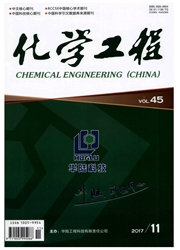

 中文摘要:
中文摘要:
生物油气化对提高生物质能利用和保护环境具有重要意义。生物油气化选择乙酸、丙酮、丙三醇、苯酚、糠醛组成的混合物作为生物油模型物,在固定床圆柱形管式反应器进行气化模拟,用吉布斯自由能最小化法对其水蒸气催化重整制氢过程进行热力学分析。应用热动力学方程和质量平衡原理推算反应器模型,估算了反应热力学参数,通过Aspen Plus中的Gibbs反应器模拟生物油在不同温度下产物的平衡组成,计算出化学平衡体系的摩尔定压热容,利用Runge-Kutta法结合Matlab软件进行求解得出催化剂床层气化转化率;考察了反应温度对平衡时气体产物的影响。在固定床圆柱形管式反应器进行气化模拟实验,得出不同反应温度时反应产物气体产率和生物油气化反应较佳反应温度,通过比较得出实验结果与模拟计算值较一致。
 英文摘要:
英文摘要:
The gasification of bio-oil is important in improving the utilization of biomass energy and the environmental protection. The mixtures of acetic acid,glycerol,urfural and phenol were selected as bio-oil model compounds. The thermodynamic analysis was carried out to understand the steam catalytic reforming hydrogen production process. Using thermal dynamic equation and mass balance principle to calculate reactor model,the mathematical model of bio-oil was studied in a fixed bed reactor. Based on Aspen Plus,the R-Gibbs reactor was selected to simulate the product equilibrium compositions of pyrolysis of bio-oil and thereby calculate the molar heat capacity. A mathematical model was established with the thermodynamic equations and mass balance principle,and the conversion rate of gasification at the catalyst bed was calculated by combining the Runge-Kutta method with the Matlab software. The effect of reaction temperature on gaseous components of the molecular balance was investigated. The gasification experiment was performed with bio-oil compounds in a small scale tubular fixed bed reactor,obtaining the conversion rate of gasification and the favorable reaction temperature at the catalyst bed. The experimental results illustrate that the calculation result of the established model agrees well with the experimental results.
 同期刊论文项目
同期刊论文项目
 同项目期刊论文
同项目期刊论文
 期刊信息
期刊信息
